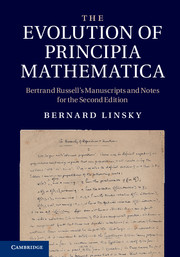 The Evolution of Principia Mathematica
The Evolution of Principia Mathematica Book contents
- Frontmatter
- Contents
- 1 Introduction
- 2 Writing the second edition
- 3 Logic since the first edition
- 4 Notation and logic
- 5 Improvements in the new edition
- 6 Induction and types in Appendix B
- 7 The reception of the second edition
- 8 The list of definitions for Carnap
- Introduction to the second edition
- Appendix A
- Appendix B
- Appendix C
- Hierarchy of propositions and functions
- Amended list of propositions: notes
- Bibliography
- Index
- Plate section
1 - Introduction
Published online by Cambridge University Press: 05 August 2011
- Frontmatter
- Contents
- 1 Introduction
- 2 Writing the second edition
- 3 Logic since the first edition
- 4 Notation and logic
- 5 Improvements in the new edition
- 6 Induction and types in Appendix B
- 7 The reception of the second edition
- 8 The list of definitions for Carnap
- Introduction to the second edition
- Appendix A
- Appendix B
- Appendix C
- Hierarchy of propositions and functions
- Amended list of propositions: notes
- Bibliography
- Index
- Plate section
Summary
The second edition of Alfred N. Whitehead and Bertrand Russell's Principia Mathematica was published by Cambridge University Press in three volumes between 1925 and 1927. It consists of a reprint of the first edition, which appeared between 1910 and 1913, with the addition of a new Introduction and three Appendices (A, B, and C) written by Russell alone, and a List of Definitions. The new material takes up only 66 pages, yet it proposed radical changes to the system of Principia Mathematica, some of which require fundamental rethinking of the nature of logic.
What Russell oddly introduces as the “…most definite improvement resulting from work in mathematical logic during the past fourteen years…” is the proposal to replace the familiar fundamental logical connectives “or” and “not” with the single “Sheffer stroke”, “not-both.” This technically trivial change is in fact carried out in a rigorous fashion and does not require any rewriting of the body of Principia Mathematica in order to be properly implemented. A second and genuinely fundamental change is the adoption of “extensionality” in the second edition. This requires that all propositional connectives are to be truth-functional, and that co-extensive propositional functions, true of the same arguments, are identified. Russell characterizes this doctrine as the result of two theses, that:
…functions of propositions are always truth-functions, and that a function can only occur in a proposition through its values.
(PM, p.xiv)What this change amounts to, and how it fits with the details of the various traces of the non-extensional system of the first edition that are unaltered, such as the definition of identity, will be discussed below.
Information
- Type
- Chapter
- Information
- The Evolution of Principia MathematicaBertrand Russell's Manuscripts and Notes for the Second Edition, pp. 1 - 12Publisher: Cambridge University PressPrint publication year: 2011